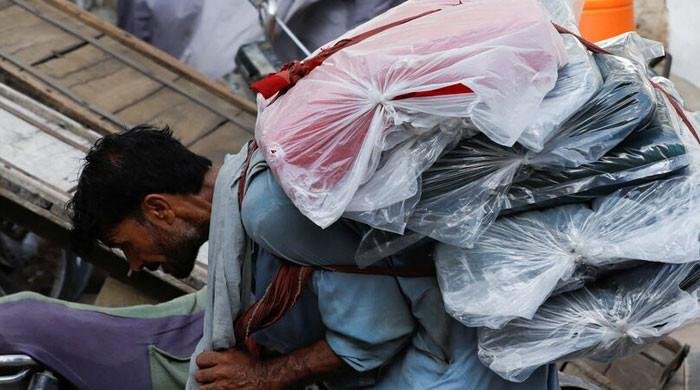The Economic Survey of Pakistan 2024-25 and Budget 2025-26 indicate that, while the present government has succeeded in stabilising the economy, it is far from the goal of a sustainable high economic growth rate which would lower the levels of poverty and unemployment and put the country on the fast track to economic prosperity.
It seems that high-level government functionaries are inadequately aware of the prerequisites of a sustainable high economic growth rate and the enhancement of the economic well-being of the ordinary citizen.
Pakistan’s success in gaining the upper hand in the recent military skirmishes with India was reassuring insofar as it established the credibility of Pakistan’s security deterrent.
But it also carries the risk of Pakistan’s leaders and policymakers ignoring the demands of Pakistan’s long-term security, which is based on economic and technological strength and scientific advancement more than anything else.
The Economic Survey 2024-25 highlights the government’s achievements in stabilising the economy while also revealing its failure to substantially accelerate the economic growth rate, reduce poverty and unemployment and enhance the development of the education and health sectors.
The present government can rightfully take some credit for stabilising the economy by gradually converting an unsustainably high level of current account deficit estimated to be 4.7% of GDP ($17 billion) in 2021-22 to a surplus estimated to be $1.9 billion in the first ten months of the current fiscal year.
Similarly, it is a matter of considerable satisfaction that the Consumer Price Index or rate of inflation has declined sharply from 29.2% in 2022-23 to 4.7% in the period from July-April, 2024-25.
But beyond the above positive indicators, the government’s economic performance has left much to be desired.
The GDP growth rate remained woefully low at 2.7% in the first ten months of the current fiscal year, not enough to improve the living conditions of the people, alleviate poverty or provide employment to the new entrants in the job market.
The national expenditure on health remained woefully low at 0.9% of GDP in 2023-24 and is likely to remain at the same low level in the current fiscal year.
Even more disappointing was the low national expenditure on education which was estimated to be only 0.8% of GDP in the first ten months of 2024-25 as against the Unesco recommendation that such expenditure should be at least 4.0% of GDP.
The low level of expenditure on education shows that most of our youth, when they enter the job market, would be either illiterate or semi-literate in the face of the challenges of the modern knowledge-based world, where advancement in sciences and technology is an indispensable condition for progress.
The budget for 2025-26 with a modest GDP growth target of 4.2% as against 2.7% in the outgoing fiscal year reflects the government’s continued focus on fiscal discipline and economic stability as against the need for a high growth rate of the economy which is an essential prerequisite for the alleviation of poverty and the lowering of unemployment.
The government, therefore, remains far from the ideal combination of a high GDP growth rate exceeding 6-7% per annum and a stable economic environment marked by a balanced budget, current account surplus, and low inflation rate. This is primarily because the government has failed so far to bring about the necessary structural reforms to achieve these goals.
As far as the issue of fiscal balance is concerned, the fundamental problem is the low level of tax-to-GDP ratio in Pakistan, which does not provide enough resources to the government for meeting its essential current and developmental requirements. During the outgoing fiscal year, the tax-to-GDP ratio is expected to be around 8.0% despite the government’s tall claims about the reforms it introduced to streamline and improve the taxation system.
Going by the FBR’s past performance, it is unlikely that the tax-to-GDP ratio during 2025-26 would exceed 10%. It is worth remembering that the average tax-to-GDP ratio in developing countries is estimated to be about 15% and ideally, it should be above 20% in our case.
Our unsatisfactory performance in collecting taxes is the main reason for our perennially high levels of fiscal deficits and our inability to finance major developmental projects through the government’s resources instead of relying on domestic and external borrowings. The former crowds out domestic lending to the private sector, and the latter increases the external debt burden.
The only way to reverse this unfortunate situation is to widen the tax base to cover adequately the income earned in the agricultural sector, real estate, and retail trade, besides drastically reducing the tax exemptions granted to various elite classes in the country. This should be combined with an austerity drive to curtail the government’s current expenditure. Budget 2025-26 unfortunately does not go far enough in this direction.
Our national savings rate, which has been estimated to be about 14% of GDP in 2024-25, is much lower than the comparable national saving rates of India (about 30%) and Bangladesh (about 34%). A high national savings rate enables a country to finance a high rate of national investment through domestic resources, thereby achieving a high GDP growth rate without having to depend on foreign loans or investment.
Our low national investment rate, estimated to be about 13.8%, explains the low GDP growth rate in the outgoing fiscal year. The moral is that if we wish to accelerate our GDP growth rate to a level above 6.0%, we will have to raise our national investment rate to over 25% of GDP, assuming a capital-output ratio of 4 to 1.
Further, if we do not wish to rely excessively on loans from abroad to finance this high level of investment, we must also raise our national saving rate to 25% of GDP or even higher. The main culprit preventing us from achieving the desired high level of national savings is the addiction of the Pakistani ruling elite to conspicuous living.
The budget does not contain any worthwhile initiatives to move the country in the desired direction by substantially raising our national savings rate.
The federal budget in its present form is an epitome of mediocrity and manifests all the ills of elite capture. It betrays woeful ignorance of the main drivers of economic progress in the modern knowledge-based world. It continues the ruling elite’s looting and plundering of the nation’s resources through continued conspicuous consumption, undeserved tax exemptions, and other privileges.
It provides little relief to the poor and the downtrodden through a rapid increase in GDP growth rate, alleviation of poverty, and enhancement of employment opportunities.
Failure to take necessary economic initiatives to increase the GDP growth rate rapidly and sustainably and accelerate scientific and technological advancement in the country also jeopardises Pakistan’s long-term security.
The writer is a retired ambassador and author of ‘Pakistan and a World in Disorder – A Grand Strategy for the Twenty-FirstCentury’. He can be reached at: [email protected]
Disclaimer: The viewpoints expressed in this piece are the writer’s own and don’t necessarily reflect Geo.tv’s editorial policy
Originally published in The News
setTimeout(function(){
var scriptElement=document.createElement(‘script’);
scriptElement.type=”text/javascript”;
scriptElement.setAttribute=”async”;
scriptElement.src=”https://www.geo.tv/assets/front/js/lazysizes.min.js”;
document.body.appendChild(scriptElement);
}, 1000);
//setTimeout(function(){ $(‘.medium-insert-images’).find(‘figure’).show() }, 3000);
var loadDeferredJS = function() {
var lazyloadjs = [‘https://www.geo.tv/assets/front/js/lazysizes.min.js’];
var alljs = [‘https://www.geo.tv/assets/front/js/ui/thirdparty.js?ver=133’];
var jqueryjs = [‘https://www.geo.tv/assets/front/js/ui/jquery.min_new.js?ver=43’];
var bootstrapjs = [‘https://www.geo.tv/assets/front/js/ui/bootstarp.js?ver=55’];
var sliderjs = [‘https://www.geo.tv/assets/front/js/ui/swiper.min.js’];
var firebaseappjs = [‘https://www.gstatic.com/firebasejs/8.10.1/firebase-app.js’];
var firebasejs = [‘https://www.gstatic.com/firebasejs/8.10.1/firebase-analytics.js’,’https://www.gstatic.com/firebasejs/8.10.1/firebase-messaging.js’];
var firebasejs_tokenjs = [‘https://www.geo.tv/assets/front/js/push_notification.js?v=1.511’];
var alljscustom = [‘https://www.geo.tv/assets/front/js/ui/my.js?ver=232366′,’https://www.geo.tv/assets/front/js/mycustom.js?ver=646’];
/*setTimeout(function(){
lazyloadjs.forEach(function (item,index) {
var scriptElement=document.createElement(‘script’);
scriptElement.type=”text/javascript”;
scriptElement.src = item;
document.body.appendChild(scriptElement);
});
}, 500);*/
setTimeout(function(){
jqueryjs.forEach(function (item,index) {
var scriptElement=document.createElement(‘script’);
scriptElement.type=”text/javascript”;
scriptElement.src = item;
document.body.appendChild(scriptElement);
});
}, 1000);
// setTimeout(function(){
// bootstrapjs.forEach(function (item,index) {
// var scriptElement=document.createElement(‘script’);
// scriptElement.type=”text/javascript”;
// scriptElement.src = item;
// document.body.appendChild(scriptElement);
// });
// }, 2000);
const jqueryIntervalcheck = setInterval(function () {
if(typeof jQuery !== “undefined”){
clearInterval(jqueryIntervalcheck);
setTimeout(function(){
sliderjs.forEach(function (item,index) {
if(item == ‘https://www.geo.tv/assets/front/js/ui/swiper.min.js’){
var story_embed_gallery = $(‘.story-area’).find(‘.embedgallery’).length;
//var story_embed_gallery = 0;
if(parseInt(story_embed_gallery) > 0){
var scriptElement=document.createElement(‘script’);
scriptElement.type=”text/javascript”;
scriptElement.src = item;
document.body.appendChild(scriptElement);
}
}
});
}, 100);
setTimeout(function(){
alljscustom.forEach(function (item,index) {
var scriptElement=document.createElement(‘script’);
scriptElement.type=”text/javascript”;
scriptElement.src = item;
document.body.appendChild(scriptElement);
});
}, 1300);
/*const jqueryIntervalcount = setInterval(function () {
if(typeof jQuery !== “undefined”){
clearInterval(jqueryIntervalcount);*/
if($(‘.infogram-embed’).length > 0 || $(’embedinfogram’).length > 0)
{
!function (e, t, n, s) {
var i = “InfogramEmbeds”, o = e.getElementsByTagName(t)[0], d = /^http:/.test(e.location) ? “http:” : “https:”;
if (/^/{2}/.test(s) && (s = d + s), window[i] && window[i].initialized)window[i].process && window[i].process(); else if (!e.getElementById(n)) {
var a = e.createElement(t);
a.async = 1, a.id = n, a.src = s, o.parentNode.insertBefore(a, o)
}
}(document, “script”, “infogram-async”, “https://e.infogram.com/js/dist/embed-loader-min.js”);
}
if($(‘.flourishClass’).length > 0)
{
var scriptElement=document.createElement(‘script’);
scriptElement.type=”text/javascript”;
scriptElement.setAttribute=”async”;
scriptElement.src=”https://public.flourish.studio/resources/embed.js”;
document.body.appendChild(scriptElement);
}
if($(‘.apester-media’).length > 0)
{
var scriptElement=document.createElement(‘script’);
scriptElement.type=”text/javascript”;
scriptElement.setAttribute=”async”;
scriptElement.src=”https://static.apester.com/js/sdk/latest/apester-sdk.js”;
document.body.appendChild(scriptElement);
}
if($(‘.twitter-tweet’).length > 0)
{
var tweetObj = document.getElementsByClassName(‘tweetPost’);
var counter_tweet = 0;
if (tweetObj.length == 0) {
tweetObj = document.getElementsByClassName(‘twitter-tweet’);
$.each(tweetObj, function (i, v) {
$(this).attr(‘id’, ‘twitter-post-widget-‘ + i);
});
} else {
$.each(tweetObj, function (i, v) {
if($(this).find(‘.twitter-tweet’).length > 0){
$(this).find(‘.twitter-tweet’).attr(‘id’, ‘twitter-post-widget-‘ + counter_tweet);
counter_tweet++;
}
});
}
$.getScript(‘https://platform.twitter.com/widgets.js’, function () {
var k = 0;
var tweet = document.getElementById(‘twitter-post-widget-‘ + k);
var tweetParent, tweetID;
while (tweet) {
tweetParent = tweet.parentNode;
//tweetID = tweet.dataset.tweetId;
tweetID = tweetParent.getAttribute(“id”);
if(tweetID === null){
tweetID = tweet.dataset.tweetId;
}
//var tweetVideoClass = tweet.getAttribute(‘class’).split(‘ ‘)[0];
$(tweet).remove();
twttr.widgets.createTweet(
tweetID,
tweetParent
);
k++;
tweet = document.getElementById(‘twitter-post-widget-‘ + k);
}
});
/*==============*/
var tweetObjVid = document.getElementsByClassName(‘tweetVideo’);
var counter_tweet = 0;
if (tweetObjVid.length == 0) {
tweetObjVid = document.getElementsByClassName(‘twitter-video’);
$.each(tweetObjVid, function (i, v) {
$(this).attr(‘id’, ‘twitter-vid-widget-‘ + i);
});
} else {
$.each(tweetObjVid, function (i, v) {
if($(this).find(‘.twitter-video’).length > 0){
$(this).find(‘.twitter-tweet’).attr(‘id’, ‘twitter-vid-widget-‘ + counter_tweet);
counter_tweet++;
}
});
}
$.getScript(‘//platform.twitter.com/widgets.js’, function () {
var v = 0;
var tweetVid = document.getElementById(‘twitter-vid-widget-‘ + v);
var tweetParentVid, tweetIDVid;
while (tweetVid) {
tweetParentVid = tweetVid.parentNode;
//tweetIDVid = tweetVid.dataset.tweetId;
tweetIDVid = tweetParentVid.getAttribute(“id”);
if(tweetIDVid === null){
tweetIDVid = tweet.dataset.tweetId;
}
$(tweetVid).remove();
twttr.widgets.createVideo(
tweetIDVid,
tweetParentVid
);
v++;
tweetVid = document.getElementById(‘twitter-vid-widget-‘ + v);
}
});
}
if($(‘.instagram-media’).length > 0){
var scriptElement=document.createElement(‘script’);
scriptElement.type=”text/javascript”;
scriptElement.setAttribute=”async”;
scriptElement.src=”https://platform.instagram.com/en_US/embeds.js”;
document.body.appendChild(scriptElement);
}
if($(‘.tiktok-embed’).length > 0){
var scriptElement=document.createElement(‘script’);
scriptElement.type=”text/javascript”;
scriptElement.setAttribute=”async”;
scriptElement.src=”https://www.tiktok.com/embed.js”;
document.body.appendChild(scriptElement);
}
if($(‘.threadsPost’).length > 0){
var scriptElement=document.createElement(‘script’);
scriptElement.type=”text/javascript”;
scriptElement.setAttribute=”async”;
scriptElement.src=”https://www.threads.net/embed.js”;
document.body.appendChild(scriptElement);
}
if($(‘.fb-video’).length > 0 || $(‘.fb-post’).length > 0){
var container_width = $(window).width();
if(container_width 0){
let embed_url = $(‘.fb-video’).attr(‘data-href’);
let htmla=”
‘;
$(‘.fb-video’).parent(‘.embed_external_url’).html(htmla);
}
else{
let embed_url = $(‘.fb-post’).attr(‘data-href’);
let htmla=”
‘;
}
}
$(‘body’).prepend(‘
‘);
var scriptElement=document.createElement(‘script’);
scriptElement.type=”text/javascript”;
scriptElement.setAttribute=”async”;
scriptElement.src=”https://connect.facebook.net/en_US/sdk.js#xfbml=1&version=v2.11&appId=580305968816694″;
document.body.appendChild(scriptElement);
}
var scriptElement=document.createElement(‘script’);
scriptElement.type=”text/javascript”;
scriptElement.setAttribute=”async”;
scriptElement.src=”https://dcc4iyjchzom0.cloudfront.net/widget/loader.js”;
document.body.appendChild(scriptElement);
/*}
},100);*/ }
},100);
};
var raf = window.requestAnimationFrame || window.mozRequestAnimationFrame ||
window.webkitRequestAnimationFrame || window.msRequestAnimationFrame;
var loadDeferredJSCaptcha = function() {
var addJSNode = document.getElementById(“captchejs”);
var replacement = document.createElement(“div”);
replacement.innerHTML = addJSNode.textContent;
document.body.appendChild(replacement);
addJSNode.parentElement.removeChild(addJSNode);
};
window.addEventListener(‘load’, loadDeferredJS);
//window.addEventListener(‘load’, loadDeferredJSCaptcha);
#budget #future



